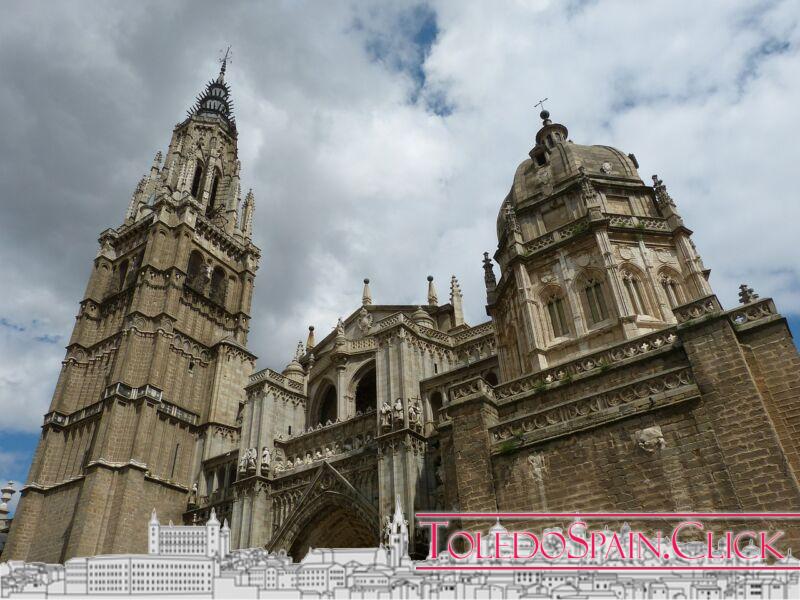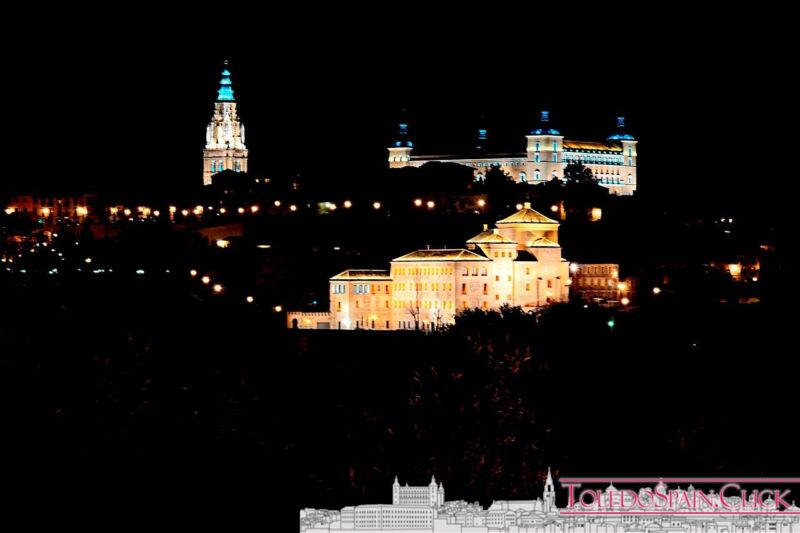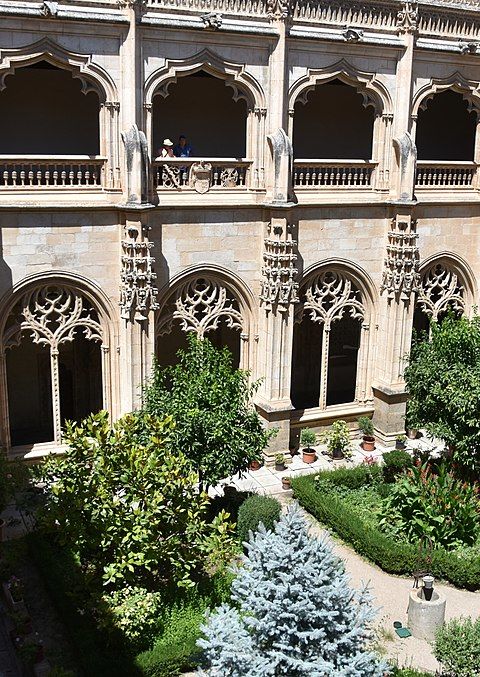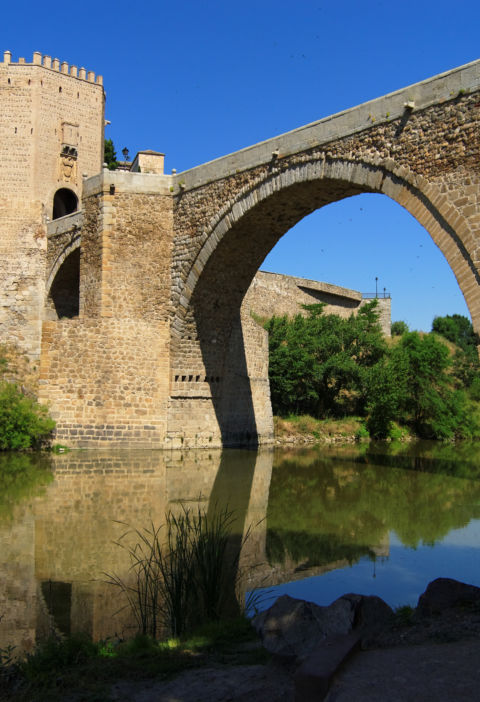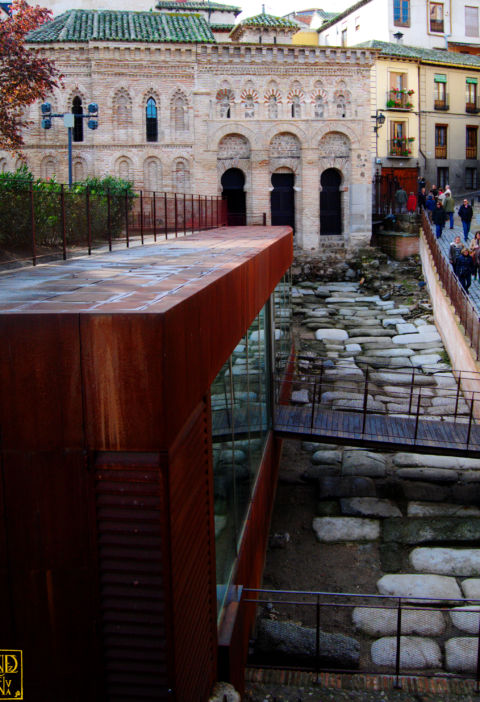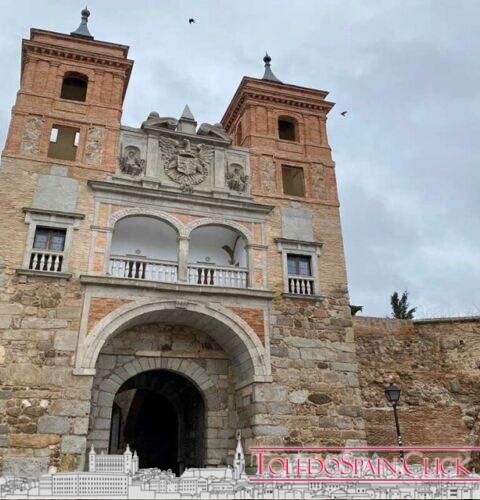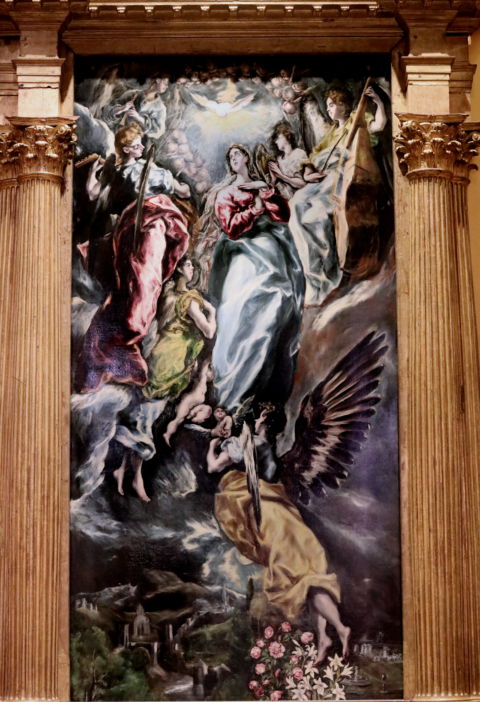The Holy Cathedral Church of Toledo begins to be built in the year 1227 on the foundations of the Visigothic Cathedral of the s. VI and which in turn was used as a mosque.
The construction is Gothic in style with a clear French influence. The plan of the temple is, therefore, a Latin cross, called a hall, as it is inscribed in the plane of a rectangle. The elevation marks the cross, creating a triangular vertical shape, since the central nave and the transept are much wider and higher than the lateral naves, with the outer naves being the lowest.
It measures 120 m long by 60 m wide. It is composed of 5 naves, supported by 88 columns and 72 vaults.
The side naves extend behind the Main Chapel, surrounding the presbytery and creating an ambulatory with a double semicircular aisle. Its first architect is Master Martín, of French origin, to whom we owe the traces of the floor plan and the beginnings of the work at the head of the temple.
It was not until the 14th century that the lateral naves could be closed and it was in this same century that the lower cloister with its dependencies was built on the north side, the most notable being the Chapel of San Blas.
In the fifteenth century, the chapel of San Pedro was built next to the entrance to the cloister and at the end of this century, in 1493, the last vault was closed, thus concluding this great construction.
In the 16th century, the altarpiece, the upper part of the choir and bars were built. In the first half of the century, all the stained glass windows were closed and various plant modifications were made, such as the chapter house, the Mozarabic chapel and the chapel of the New Kings.
To admire the grandeur of the cathedral, it is best to climb one of the towers in Toledo (the Library of Castilla-La Mancha, in the Alcázar, or the Church of the Jesuits). From there we will see the roofs of the cathedral forming a perfect cross, surrounded by aerial flying buttresses and slender pinnacles.
The oldest door of the temple is that of the north transept, inspired by the corresponding door of the Parisian cathedral of Notre Dame, given the great importance that the French Gothic granted to these entrances.
The mullion with the Virgin and Child introduces the theme of scenes from the life of Christ, carved on his tympanum.
It is a kind of catechism in stone for the faithful of the thirteenth century. You have to read it continuously starting from the lower left corner, from the Annunciation to the Last Judgment and the Transit of the Virgin at the top.
Its current stone dome is from the early 17th century, covering the Corpus Christi chapel, intended by Cardinal Cisneros to recover the Mozarabic rite, replaced by the Catholic, coinciding with the Christian conquest of Toledo in 1085.
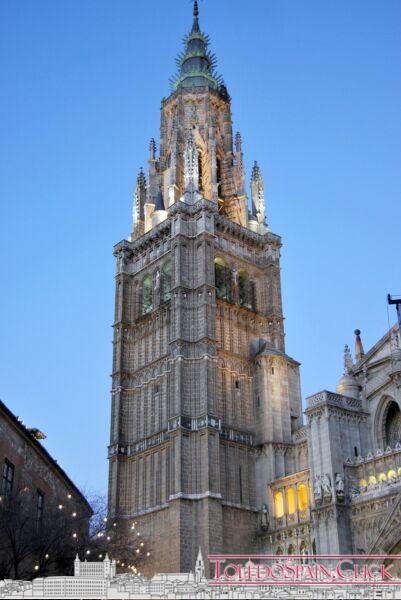
Index of Contents
TOWER
The tower can be visited and we can climb to the top to enjoy an amazing panoramic view. With its ninety meters of height, it was finished with the last octagonal body, topped with the slate alcuzón and the three crowns by the master Hanequin of Brussels in the fifteenth century.
DOORS
The main façade has three access doors, that of Forgiveness or the Kings in the center, that of Las Palmas or Hell next to the tower and that of the Escribanos or Juicio adjoining the Mozarabic Chapel.
Two others are the aforementioned door of the north transept, called the Fair, the Chapinería, the Lost Child or the Clock, placed by order of Cardinal Lorenzana, at the end of the 18th century to mark the canonical hours, hence it only has a hand And, finally, the Puerta de los Leones, in the south transept, combining Gothic and Baroque sculptures, all of excellent quality.
Up to here the orthodox Gothic layout is fulfilled. However, the Toledo cathedral has more entrances, two of which communicate with the cloister, the Presentation and Santa Catalina, and the last, unusual due to its location on the south wall, the neoclassical Puerta Llana, the only one that does not have steps.
This modest “service” door, which for centuries allowed all the stonework and sculptures for the temple to enter, became the noble portico for the passage of the famous Custody, when it majestically leaves in Corpus Christi procession.
Currently it is also the gateway for visitors. The cloister is entered through the Puerta de Mollete and there are five other auxiliary doors in the walls of the structures added to the temple.
Inside the Cathedral of Toledo there are areas that, together with their respective works of art, require a visit and a leisurely look. They are the so-called Cathedral Museums: The Sacristy, the Treasury, the Chapter House, the Choir and the Transparent.
CHAPELS AND CHAPTER ROOM
Inside, the main chapel is one of the places in the Cathedral that houses more works of art. Originally closed by a railing carved in stone, part of which is still preserved, it houses a large number of statues.
On the two pillars that give access to the chapel we see, on the left, the legendary shepherd Martín Alhaja, who gave very relevant information to win the battle of Las Navas de Tolosa.
On the right, the Alfaquí, portrait of Abu Walid, a Muslim who brought a message of tolerance to Alfonso VI, betting on the coexistence of Arabs and Christians.
Inside we find the ironwork, of great quality, and the great altarpiece, the summit of flowery Gothic and its last manifestation before the arrival of the Renaissance. In contrast to it, the tomb of Cardinal Mendoza, attributed to the Italian Antonio Sansovino, is one of the first manifestations of Renaissance art in Castile.
The Mozarabic chapel is of special interest for having been designated by Cardinal Cisneros to restore the Mozarabic rite in Toledo.
This way of celebrating mass had been preserved among the Christians who lived in Muslim territory, since the Visigothic domination.
The dome of the chapel is the work of El Greco’s son, Jorge Manuel Theotocópuli, the bronze and marble altar of various colors, by Juan Manzano, and the Gothic ironwork by Juan Francés, from 1524.
The chapel of the New Kings, today without worship, forms a small church, whose vestibule is by the architect Alonso de Covarrubias. Named in honor of the new Trastámara dynasty reigning in Castile, it houses numerous sepulchres of its kings, with interesting carvings.
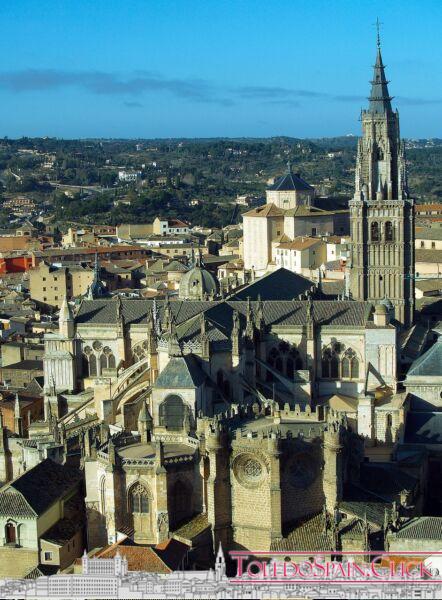
Among the chapels of the ambulatory, the access to the Chapter House stands out, with rich plateresque ornamentation, and the portraits of all the archbishops of Toledo. Above them, one of the great groups of Spanish fresco painting, the work of Juan de Borgoña.
PAINTING
The collection preserved in the Sacristy is excellent, with El Expolio and El Apostolado by El Greco, paintings by Caravaggio, Titian, Van Dyck, Goya, Morales, Rubens, Bassano and many more.
It is worth mentioning Juan de Borgoña and Lucas Giordano separately, since their most outstanding paintings are the frescoes that cover the walls of the Chapter House, in the case of the former, and the ceiling of the Sacristy, in the latter.
STAINED GLASS, TRANSPARENT AND TREASURE
The Primate Cathedral of Toledo houses the largest number of preserved medieval stained glass windows, such as those in the rose window of the transept, those in the main chapel and those of large figures of saints and apostles on the east side.
The so-called Transparent is the great masterpiece of the sculptor Narciso Tomé, completed in 1732, and made of Genoese marble, jasper and bronze.
Conceived as an altarpiece, and illuminated by the skylights of the apse, it presents numerous figures and compositions representing passages from the Bible.
Another type of art that is very present is goldsmithing. The treasure keeps reliquaries, staffs, clothes and liturgical objects in multiple display cases, among which some of great historical value stand out.
But without a doubt, the most spectacular is exhibited in the cathedral treasury: the imposing Monstrance of Enrique de Arfe, made up of countless lace-like pieces of gold-plated silver Gothic filigree; the precious case for the true monstrance of the Sacred Form, a “small monstrance” of pure gold, made with the first gold that Christopher Columbus brought from America and belonging to the Catholic Monarchs.
Once a year, the Custody of Arfe takes to the streets of the city to exalt the faith during the secular Corpus Christi procession.
SCULPTURE
The rich sculptural repertoire present in each corner has doctrinal and didactic functions, in addition to the artistic ones. The outside choir shows numerous scenes from the old testament, and the Main Chapel from the New.
ACCESS
Hours and rates: Visit website.

